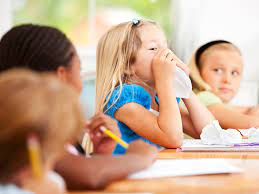Children attending elementary school (6-10 years) are perfectly able to understand the fundamental check it out notions on the methods of transmission of influenza and other infectious diseases and the importance of respecting some simple rules of hygiene which help to avoid them.
Much more difficult is being able to make them remember and apply them at the right time and convince them that the minimum effort required will be amply repaid in terms of health. To facilitate the internalization of the fundamental preventive behaviors and their adoption during the hours spent at school, outside the direct control of an adult in the family, it is important to present the explanations of the “how”, the “when” and the “why” as a game.
RECOMMENDATIONS TO PREVENT INFLUENZA AMONG SCHOOLS (6-10 YEARS OLD)
For example, as a strategy to defend one’s castle (the organism) from enemies trying to attack it (ie, viruses and bacteria).
The main preventive recommendation for children between 6-10 years of age is frequent hand washing, especially after going to the bathroom, before eating a snack or sitting down at the table in the school canteen, after playing during recess and after carrying out activities group with classmates.

Children must be reminded to always use soap and water or disinfectant gels (possibly, organizing themselves with the other parents and teachers to always have them available, if there is no one at school) and to rub their hands well, counting slowly at least three times up to ten.
Since during school hours there are always fewer opportunities to wash your hands than the circumstances in which it would be necessary to do so, it is useful to put a pack of disinfectant gel and wet wipes in the schoolbag, to be used several times throughout the morning.
Another aspect to consider is the tendency of children to exchange pencils, ballpoint pens and felt-tip pens, inevitably not very clean and, often, unknowingly brought to the mouth and nibbled.
Transport for viruses and bacteria
In general, and especially during the months when respiratory infections are most prevalent, the child should be advised not to put any objects of their own or others’ in his mouth and, in general, avoid borrowing school materials from his classmates, except in cases of real need.
Hands, even if repeatedly washed, are never perfectly clean and represent
- Therefore, it should be recommended never to get them too close to the mouth, nose and eyes, because these three parts of the face are the preferred entry points for pathogenic microorganisms.
- An exception to this rule can be made in case of a cold: when sneezing, the mouth should always be covered to avoid spreading too many germs into the environment.
To do this, the ideal is to bring the mouth and nose close to the crook of the elbow, but in a hurry the hand is also fine (preferably covered with a handkerchief and washed or disinfected immediately afterwards).
Other relevant congenital diseases
Always in case of a cold, the child should be reminded to blow his nose often, supplying him with an adequate supply of paper handkerchiefs to be thrown away immediately after use in the classroom wastebasket.

It is forbidden to accumulate virus-filled bullets in your pockets or under the counter, nor throw them at your teammates’ heads (it’s not kind or healthy).
In addition to practical prevention strategies, it should be remembered that the administration of the seasonal flu vaccine is the most effective way to avoid the flu.
Vaccination is indicated and safe at all ages and is particularly recommended in children suffering from asthma or other chronic respiratory diseases, immunodeficiencies, cardiac or metabolic disorders (such as type 1 diabetes).
How to Prevent Seasonal Flu.
Generality. Seasonal flu is the most feared of winter diseases: in fact, it is a contagious infectious disease, so much so that many contract it with the arrival of cold weather and almost every year we witness the appearance of real epidemics , more or less serious depending on the influenza viruses involved.
Causes of Influenza
Despite these considerations, seasonal influenza continues to be underestimated, as it is often considered a trivial disease.
In reality, this is not the case: normally, the flu resolves itself in a few days, but, when the most fragile categories of the population are affected (such as the elderly or people with chronic diseases), it can overlap with other ailments and can cause even serious complications.
Understanding how infection is transmitted and how infection can be prevented is the key to reducing the number of infections, hospitalizations and premature deaths.
Influenza: What is it?
Influenza is an acute infectious disease involving the respiratory system (nose, throat and lungs). The contagion follows a typically seasonal trend: in Italy, the peak is recorded approximately from December to the end of February or.
The respiratory tract infection underlying influenza is sustained by RNA viruses belonging to the Orthomyxovirus genus. One of the peculiarities of the viral strains that cause seasonal flu is the great ability to mutate, i.e. they change at the genetic level, assuming slightly different characteristics every year.
